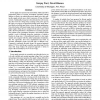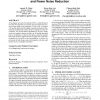15 search results - page 1 / 3 » Decoupling capacitance efficient placement for reducing tran... |
ICCAD
2009
IEEE
13 years 2 months ago
2009
IEEE
Decoupling capacitance (decap) is an efficient way to reduce transient noise in on-chip power supply networks. However, excessive decap may cause more leakage power, chip resource...
VLSID
2002
IEEE
13 years 9 months ago
2002
IEEE
Power supply noise is a strong function of the switching activities of the circuit modules. Peak power supply noise can be significantly reduced by judiciously arranging the modu...
ICCD
2006
IEEE
14 years 1 months ago
2006
IEEE
The placement of on-die decoupling capacitors (decap) between the power and ground supply grids has become a common practice in high performance processor designs. In this paper, ...
ASPDAC
2007
ACM
13 years 8 months ago
2007
ACM
Power supply noise increases the circuit delay, which may lead to performance failure of a design. Decoupling capacitance (decap) addition is effective in reducing the power suppl...
GLVLSI
2005
IEEE
13 years 10 months ago
2005
IEEE
3D packaging via System-On-Package (SOP) is a viable alternative to System-On-Chip (SOC) to meet the rigorous requirements of today’s mixed signal system integration. In this wo...


